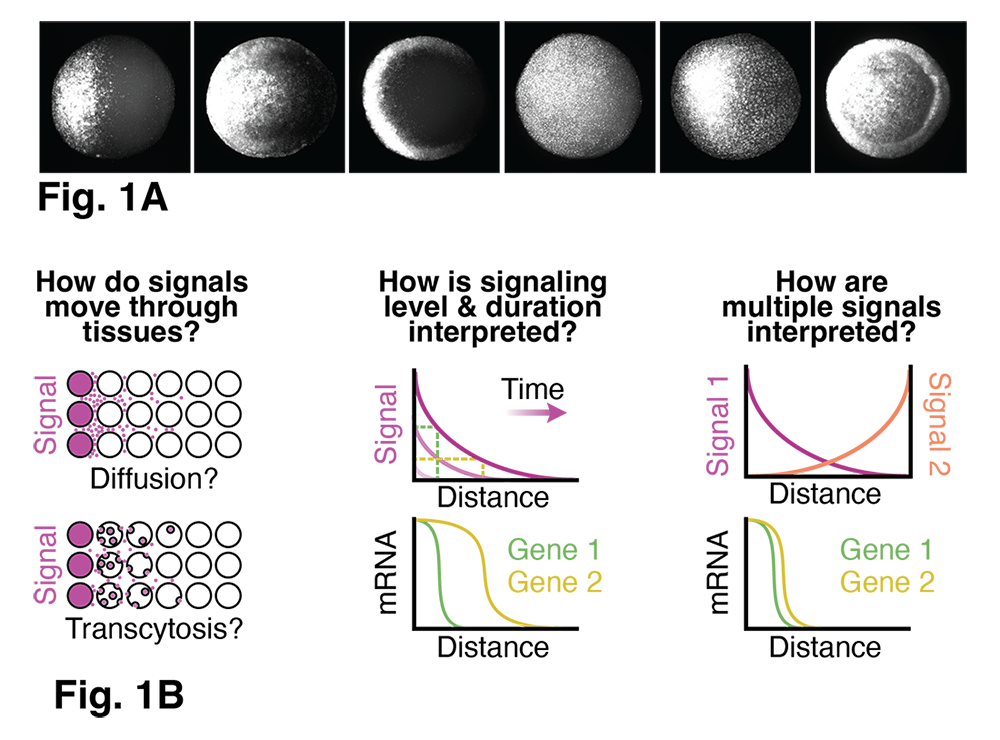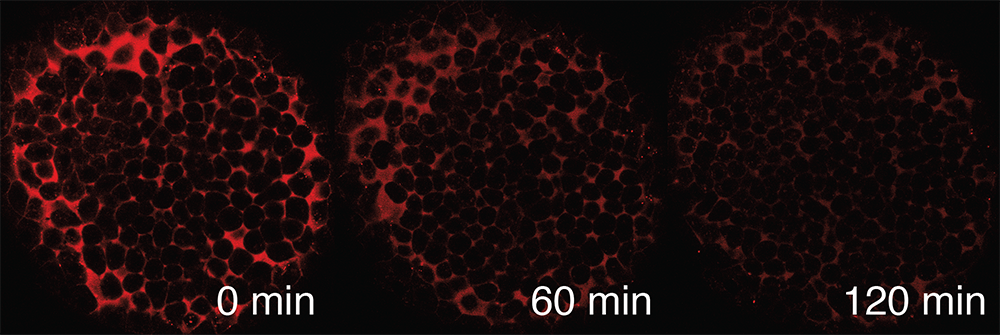Decoding Developmental Signaling in Vertebrate Embryos
- Katherine W. Rogers,
PhD, Head, Unit on Developmental Signaling - William K. Anderson, BS, Research Technician
- Caitlin Donahue, PhD, Postdoctoral Researcher
- Leanne E. Iannucci, PhD, Postdoctoral Researcher
- Selvaraj Velanganni, PhD, Postdoctoral Researcher
- Catherine E. Rogers, BS, NIH-Johns Hopkins University Graduate Partnership Program Student
- Matthew T. Monaghan, BS, Postbaccalaureate Fellow
- Micaela R. Murphy, BS, Postbaccalaureate Fellow

To create the different tissues required in healthy adults, embryos must activate fate-specifying genes in a variety of stereotyped patterns (Figure 1A), a process that is mediated by signaling molecules that spread though embryonic tissues. Signaling levels, dynamics, and their combinations are known to influence gene expression. However, it is not clear which of these signaling features are ‘decoded’ by individual genes and how those features are converted into differential gene expression during vertebrate embryogenesis.
We investigate how signaling molecules spread through embryonic tissues, how signaling levels and dynamics are decoded, and how many pathways cooperate to pattern the body plan (Figure 1B). To directly examine these processes, we use molecular optogenetics approaches that offer tunable, reversible experimental manipulations with excellent temporal (seconds) and spatial (subcellular) resolution. Using the microscopy-friendly zebrafish embryo as a vertebrate model system, our lab harnesses established optogenetic approaches and develops new ones to understand how cells decode signaling during embryogenesis.
How do signaling molecules move through tissues?
The distribution of signaling molecules within developing tissues helps determine patterns of gene expression. Competing models have been proposed to explain how signaling-molecule distributions are established: signals may diffuse away from producing cells through the extracellular space, move through cells (transcytosis), or be confined to the producing cells themselves. We will develop optogenetic tools to probe how extracellular diffusion and transcytosis, among others, affect signaling-molecule distribution, and we will use these with in vivo methods, including FRAP (fluorescence recovery after photobleaching) and FDAP (fluorescence decay after photoactivation) (Figure 2), to directly measure signaling-molecule mobility and stability. This will help determine how signaling-molecule distribution is regulated during zebrafish embryogenesis.
What information is encoded in signaling gradients?
Signaling gradients are found in developing tissues from the fly wing precursor to the mammalian neural tube. The classic morphogen model proposes that the precise shape of signaling gradients is important because genes are activated by different signaling levels. Alternatively, a simple signaling asymmetry may suffice to pattern tissues in some contexts. The relatively subtle signaling perturbations required to distinguish between these models can be difficult to achieve in vivo. We are using optogenetic tools together with a digital micromirror device to introduce novel signaling distributions in zebrafish embryos and assess patterning consequences (Figure 3). This will determine the spatiotemporal signaling requirements for normal tissue patterning during early development.
How are signaling levels, dynamics, and combinations interpreted in the embryo?
To understand how cells in developing tissues make fate decisions, we seek to determine the input/output relationship between signaling and gene expression during early vertebrate embryogenesis. To achieve this, we are first thoroughly characterizing a suite of blue light–responsive optogenetic tools that reversibly activate signaling by the signaling molecules BMP (bone morphometric protein) and FGF (fibroblast growth factor), and by Nodal (a transforming growth factor β-related signal) in zebrafish embryos: We are determining their on/off kinetics, light-intensity dependence, signaling-pathway specificity, and wavelength dependence. We are also developing transgenic zebrafish ubiquitously and tissue-specifically expressing these optogenetic tools. Next, we are using these tools to manipulate signaling levels and dynamics in developing embryos. We then characterize gene responses and investigate the DNA–level mechanisms responsible for differential responses. This will help determine which features of signaling encode information and explain how the diverse gene expression patterns needed to produce healthy adults are robustly generated.
Publications
- Optogenetic signaling activation in zebrafish embryos. J Vis Exp 2023 10.3791/65733
- Optogenetic investigation of BMP target gene expression diversity. eLife 2020 e58641
- Optogenetic approaches to investigate spatiotemporal signaling during development. In: Gradients and Tissue Patterning. Small S, Briscoe J, eds, 2020 37–77
- Nodal patterning without Lefty inhibitory feedback is functional but fragile. eLife 2017 e28785
- Dynamics of BMP signaling and distribution during zebrafish dorsal-ventral patterning. eLife 2017 e25861
Contact
For more information, email katherine.rogers@nih.gov or visit https://www.nichd.nih.gov/research/atNICHD/Investigators/rogers.




